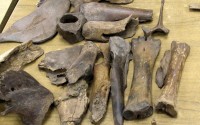Animals in York: reflections on the zooarchaeological record
- Date
- 9 Dec 2014
- Start time
- 7:30 AM
- Venue
- Tempest Anderson Hall
- Speaker
- Terry O'Connor

Animals in York: reflections on the zooarchaeological record
Terry O’Connor, Department of Archaeology, University of York
Archaeologists and zoologists have been studying animal bones from excavations in York for over 30 years. In that time, we have learned a great deal about the birds, mammals and fish that have been used by people or shared human living spaces in the city over two millennia. What is more remarkable is that there continue to be great gaps in our knowledge, some of which require more evidence and some that require thinking about the evidence we do have in different ways. This talk reviews York from the 1st to the 21st centuries, reflecting on what we think we know about the mutual interplay between people and other animals at different times and in different neighbourhoods, and exploring some of those unanswered questions for the future. Farm livestock feature large in this story, but there are important walk-on parts for ducks, rats, guillemots, cats and, of course, frogs.
Report
Animals were a significant part of the population of York, a crucial part of life. In earlier times the people of York lived cheek by jowl with animals in an integrated community. However, an unpleasant picture was painted of conditions on the streets, the result of open-air butchering of mainly cattle. Refuse, including high levels of stomach contents, smells, flies and general squalor.
Archaeological remains include disproportionate numbers of very young lambs which suggests possible culling of young males or perhaps something ceremonial. Whereas the mix of animals varied over the centuries, small numbers of pigs have been a constant. The idea that they were used to clear refuse has been disproved, though foxes, usually attracted by such delights, seemed surprisingly rare. They were probably chased away by the small feral cats, natural enemies of foxes, that roamed in large numbers.
On the domestic front, pet dogs may in fact have been tame wolves. People also kept tame jackdaws and to a lesser degree ravens. Chickens were kept for their eggs. In the wild, frogs were everywhere; white-tailed eagles regular scavengers; with unusual traces of black grouse in the record. Unsurprisingly, rat populations fluctuated with ship numbers visiting the port.
Ken Hutson
The talk was preceded by presentation of the annual Charles Wellbeloved and Herbert Ramm prizes for the best archaeological dissertations by undergraduate and postgraduate students respectively.